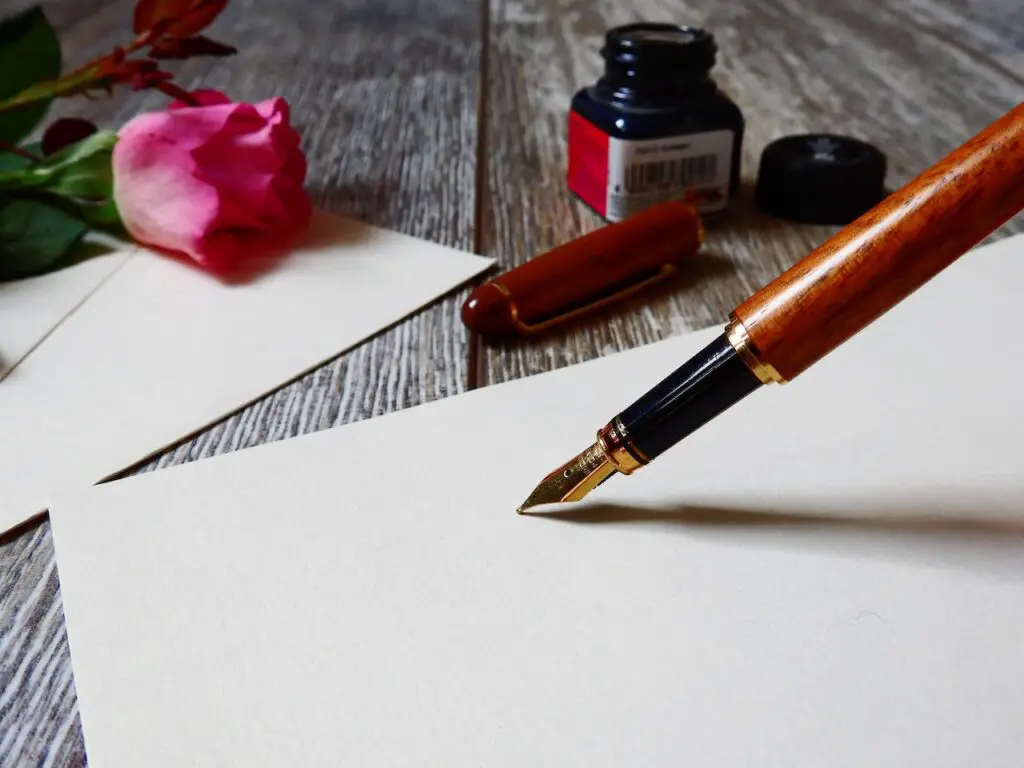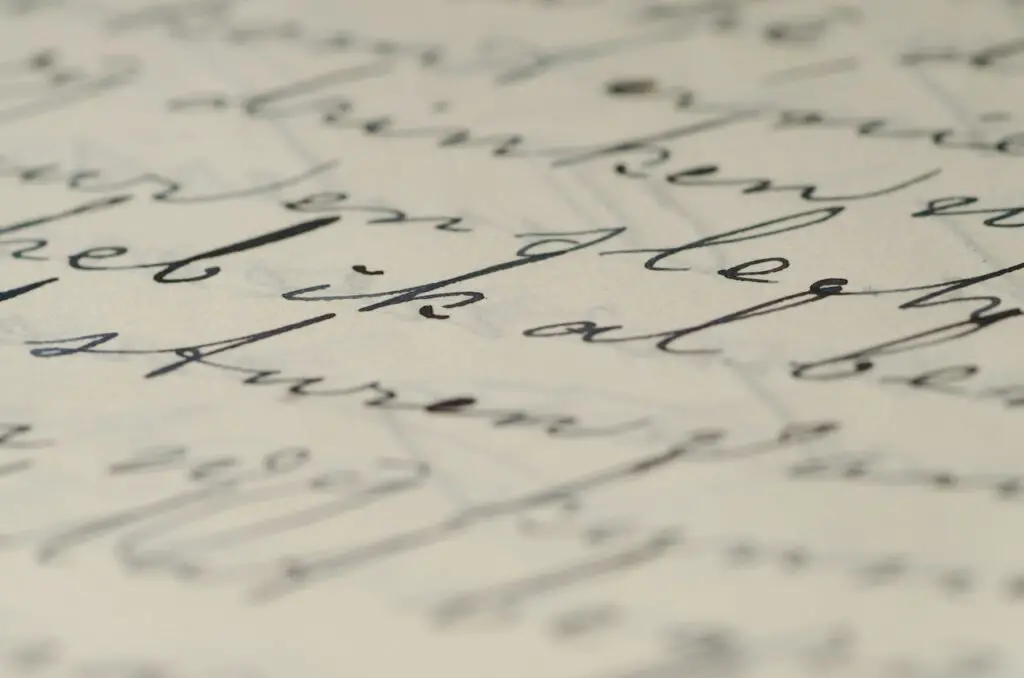In this digital age, where most communication happens through typing and tapping on keyboards, the art of writing by hand is often overlooked. However, honing your penmanship skills and mastering the art of correspondence can have numerous benefits. Whether you want to impress others with your elegant handwriting or convey your thoughts effectively through written words, this article will provide you with valuable tips for improving your penmanship and enhancing your correspondence skills.
The Importance of Penmanship
The importance of penmanship cannot be overstated. In a digital age dominated by keyboards and touchscreens, the act of writing by hand holds a special significance. It is a personal and tangible expression of oneself that conveys a sense of thoughtfulness and authenticity. Penmanship has the power to leave a lasting impression on others, whether it’s through a beautifully written note, a heartfelt letter, or an elegantly crafted signature.
Moreover, developing good penmanship skills can enhance cognitive abilities, fine motor skills, and hand-eye coordination. It fosters a sense of pride and self-confidence, allowing individuals to communicate their ideas and emotions effectively through the written word.
Related: The Art of Written Communication: Essential Tips for Men in Business

Tips for Improving Penmanship
To improve your penmanship and create beautiful, legible handwriting, consider the following tips:
Proper Hand Position and Grip
Proper hand position and grip play a crucial role in achieving optimal penmanship. When it comes to writing, holding the pen or pencil correctly is essential for control, comfort, and fluidity of movement. By maintaining a relaxed grip and positioning the hand in a way that allows for stability and ease of movement, individuals can avoid strain and fatigue.
This, in turn, promotes smoother and more consistent letter formation. By consciously practicing and maintaining proper hand position and grip, writers can improve their penmanship and enjoy a more comfortable and enjoyable writing experience.
Consistency in Letter Formation
Consistency in letter formation is a key aspect of developing good penmanship. When writing by hand, each letter should be shaped consistently, following a set of predefined strokes and guidelines. This uniformity in letter formation enhances the overall legibility and aesthetic appeal of the writing. By paying attention to the size, shape, and proportions of each letter, writers can create a visually pleasing and cohesive script.
Consistent letter formation also improves reading comprehension, as it allows readers to easily recognize and interpret the written words. Through practice and attention to detail, writers can achieve a harmonious and well-formed script that showcases their penmanship skills.
Practice Regularly
Regular practice is a fundamental component of improving penmanship. Consistency and repetition are key to refining writing skills and developing muscle memory. By dedicating regular time to practice, writers can gradually enhance their handwriting. Engaging in daily writing exercises, such as copying passages or tracing letters, helps to reinforce proper letter formation, improve hand coordination, and increase writing speed.
Over time, the act of writing becomes more natural and effortless. By making practice a habit, writers can witness tangible progress in their penmanship and gain confidence in their ability to create beautifully written words.
Slow Down and Take Your Time
Slowing down and taking the time to write deliberately is an essential tip for improving penmanship. Rushing through the writing process often leads to sloppy and illegible handwriting. By consciously slowing down the pace and focusing on each stroke, writers can ensure greater precision and control over their letter formation.
This deliberate approach allows for the creation of well-shaped and visually appealing letters. Moreover, taking one’s time promotes a sense of calm and concentration, resulting in a more enjoyable writing experience. By valuing quality over speed, writers can produce written works that reflect their dedication to the art of penmanship.
Related: The Do’s and Don’ts of Email Communication

Choosing the Right Writing Instruments
Choosing the right writing instruments is crucial for achieving optimal penmanship and enhancing the writing experience. The type of pen or pencil you use can significantly impact the quality of your handwriting. Here are some factors to consider when selecting the perfect writing instrument:
Comfort
Opt for a pen or pencil that feels comfortable in your hand. The grip should be ergonomic, providing a firm yet relaxed hold. Experiment with different sizes and shapes to find the one that suits your hand and writing style.
Ink Flow
The ink flow of a pen determines how smoothly it glides across the paper. A pen with consistent and controlled ink flow allows for effortless writing and consistent lines. Test different pens to find the one that offers a smooth and consistent writing experience.
Line Thickness
Consider the line thickness that suits your handwriting style. Some pens offer a fine point for precise and neat writing, while others provide a broader line for a bolder appearance. Experiment with different nib sizes to find the one that complements your handwriting.
Pressure Sensitivity
Different writing instruments require varying amounts of pressure to create legible marks. Some pens, like fountain pens, require a light touch, while others, like ballpoint pens, can handle a bit more pressure. Choose a pen that aligns with your preferred writing pressure for optimal control and comfort.
Ink Type
Different ink types can affect the appearance and longevity of your writing. For example, gel pens offer vibrant colors and smooth ink flow, while ballpoint pens provide a more consistent and long-lasting ink. Consider your preferences regarding ink color, drying time, and archival quality when selecting a writing instrument.
Lead Hardness
If you prefer using pencils, pay attention to the hardness of the lead. Softer leads (e.g., 2B or 4B) create darker and smoother lines, while harder leads (e.g., 2H or 4H) produce lighter and crisper lines. Choose a lead hardness that suits your writing style and the type of paper you frequently use.
Paper Compatibility
Different writing instruments perform differently on various types of paper. Test your preferred pens or pencils on the paper you commonly use to ensure they glide smoothly and produce the desired results. Consider the paper’s texture, weight, and absorbency when selecting writing instruments.
Related: Communication Tips for Men: How to Improve Your Interpersonal Skills

Enhancing Correspondence Skills
Writing correspondence involves more than just penmanship. To create compelling and effective messages, consider the following tips:
Writing Clear and Concise Messages
Writing clear and concise messages is essential for effective communication. When composing letters or emails, it is important to express your thoughts, ideas, or intentions in a straightforward and understandable manner. Avoid unnecessary jargon, excessive detail, or convoluted sentences that can confuse the reader.
Instead, use simple and precise language to convey your message concisely. By being clear and concise, you ensure that your communication is easily comprehensible, saves the reader’s time, and allows your intended meaning to come across accurately.
Structuring Letters and Emails
Structuring letters and emails appropriately is crucial for organizing your thoughts and ensuring effective communication. A well-structured message includes a clear introduction, body, and conclusion. Start with a concise greeting or salutation, followed by a brief introduction that captures the purpose of your communication.
In the body, present your main points in a logical and organized manner, using paragraphs and bullet points to enhance readability. Finally, conclude your message with a closing remark or call to action. A well-structured letter or email helps the reader navigate the content smoothly and ensures that your message is conveyed effectively.
Using Proper Grammar and Punctuation
Using proper grammar and punctuation is vital for conveying your message accurately and professionally. Correct grammar ensures that your sentences are clear, coherent, and easily understood. It helps to avoid confusion and misinterpretation. Additionally, appropriate punctuation marks, such as commas, periods, and quotation marks, provide structure and clarity to your writing.
They help to separate ideas, indicate pauses, and emphasize key points. By employing proper grammar and punctuation, you demonstrate your attention to detail and enhance the overall readability and professionalism of your written communication.
Adding a Personal Touch
Adding a personal touch to your writing can greatly enhance its impact and create a stronger connection with the reader. Consider incorporating personal anecdotes, experiences, or insights that relate to the topic at hand. Address the recipient by name and use a friendly and conversational tone.
This approach helps to establish rapport and makes your writing more relatable and engaging. By infusing your unique voice and perspective, you create a memorable and authentic experience for the reader, fostering a sense of connection and resonance that goes beyond mere information exchange.
The Role of Technology in Writing
The role of technology in writing has become increasingly prominent in today’s digital age. While traditional pen and paper hold their charm, digital tools offer a range of advantages for writers.
Efficiency and Convenience
Technology enables faster and more efficient writing processes. Typing on a keyboard allows for quick and effortless composition, eliminating the need for erasures or crossed-out words. Additionally, digital platforms offer features like spell-check, grammar correction, and auto-suggestions, enhancing the accuracy and speed of writing.
Editing and Formatting
Digital tools provide extensive editing and formatting options. Writers can easily rearrange paragraphs, change font styles and sizes, add headings, and insert hyperlinks. These features make it simpler to structure and organize written content, resulting in more visually appealing and reader-friendly documents.
Collaboration and Feedback
Online platforms and document sharing tools facilitate collaboration among writers. Multiple individuals can work simultaneously on a document, making it easier to co-author or seek input from others. The ability to share drafts and receive real-time feedback from colleagues or mentors enhances the quality of the writing and encourages growth as a writer.
Research and Reference
The internet offers a vast repository of information that writers can access for research and reference purposes. Online databases, search engines, and digital libraries provide quick access to a wide range of sources, enabling writers to gather information, fact-check, and include accurate references in their work. This wealth of information contributes to the depth and credibility of their writing.
Digital Publishing and Distribution
Technology has revolutionized the publishing and distribution process. Writers can now self-publish their work online, reaching a global audience without the need for traditional publishing channels. Digital platforms, blogs, and e-books have opened up new avenues for writers to share their content and build their readership.
Conclusion
Mastering the art of writing is a worthwhile endeavor. By improving your penmanship and correspondence skills, you can create a lasting impact with your words. Remember to practice regularly, choose the right writing instruments, and pay attention to clarity and personalization. Embrace both traditional and digital methods to become a versatile communicator. So pick up your pen or sit at your keyboard, and let the art of writing be your gateway to effective and meaningful communication.
FAQs
What is the best pen for improving penmanship?
There isn’t a single best pen for everyone, as it largely depends on personal preference. However, fountain pens are often recommended for their smooth writing experience and the control they offer over line thickness.
How often should I practice my handwriting?
Consistent practice is key to improving penmanship. Aim to practice for at least 15-30 minutes every day to see noticeable progress over time.
Can I use digital tools to improve my writing skills?
Yes, digital tools can be beneficial for improving writing skills. They offer features like autocorrect, spell-check, and formatting options. Additionally, online platforms provide opportunities for collaboration and feedback from others.
What should I include in a well-structured letter?
A well-structured letter should include a friendly greeting, a body that elaborates on your main points, and a closing remark with your signature. Break up information using paragraphs and bullet points to enhance readability.
How can I add a personal touch to my correspondence?
To add a personal touch, address the recipient by name, include relevant details or anecdotes, and express genuine interest or appreciation. Personalizing your messages helps create stronger connections and makes your correspondence more memorable.

